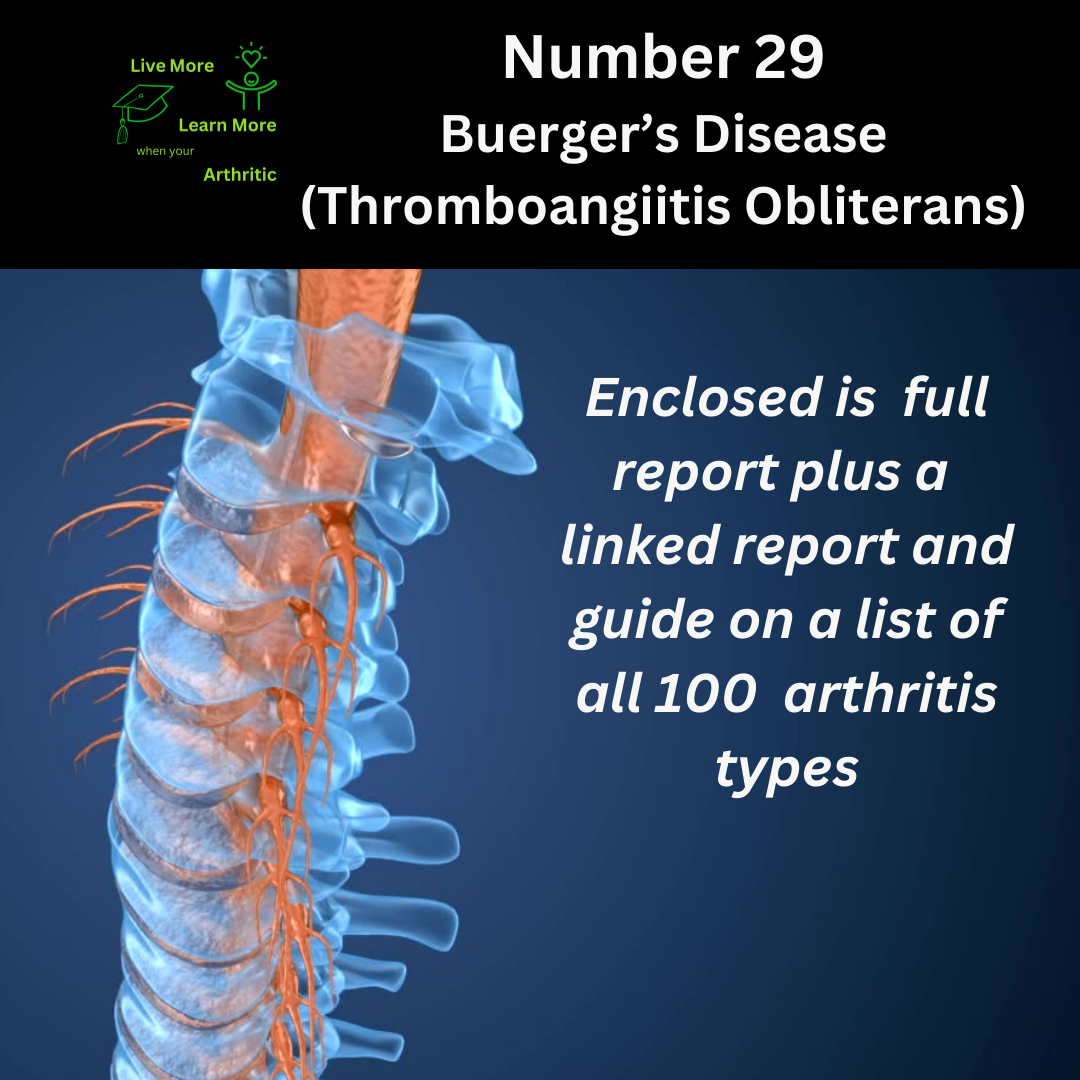
Buerger’s Disease (Thromboangiitis Obliterans): Number 29 on the list of 100 types of Arthritis
Navigating Life with Buerger’s Disease: A Tale of Resilience and Hope
Chapter 1: The Unpredictable Beginning
Imagine being a young adult and suddenly experiencing intense pain, numbness, and discoloration in your fingers or toes. This could be the bewildering onset of Buerger’s Disease (Thromboangiitis Obliterans), a rare and challenging condition affecting blood vessels.
 Chapter 2: Unveiling Buerger’s Disease
Chapter 2: Unveiling Buerger’s Disease
Buerger’s Disease, also known as Thromboangiitis Obliterans, is a rare form of vasculitis that primarily affects small- and medium-sized arteries and veins in the arms and legs. The inflammation and clotting that occur in these blood vessels can lead to reduced blood flow, causing pain, tissue damage, and potentially severe complications.
Chapter 3: The Root Causes and Triggers
The exact cause of Buerger’s Disease remains unclear, but it is strongly associated with tobacco use. Smoking is considered the primary risk factor and trigger for the development and progression of the disease. Other factors, such as genetic predisposition and immune system abnormalities, may also play a role.
Chapter 4: Symptoms and Signs
The hallmark symptoms of Buerger’s Disease include:
- Pain: Intermittent pain in the fingers, toes, hands, or feet, often worsened by cold temperatures or physical activity.
- Numbness and Tingling: Reduced sensation or tingling sensations in the affected limbs.
- Pale or Blue Skin: Skin discoloration due to reduced blood flow.
- Ulcers and Gangrene: Chronic non-healing ulcers or tissue death (gangrene) in severe cases.
Chapter 5: Onset and Demographics
Buerger’s Disease typically affects young to middle-aged adults, most commonly between the ages of 20 and 40. It is much more prevalent in men than women, especially those who are heavy smokers.
Chapter 6: Impact on Quality of Life and Lifespan
Buerger’s Disease can significantly impact quality of life due to chronic pain, disability, and the risk of serious complications like tissue death requiring amputation. While the disease itself does not directly shorten lifespan, complications from severe cases can have life-threatening consequences.
Chapter 7: Achieving a Higher Quality of Life
A proactive approach to managing Buerger’s Disease is essential for improving quality of life and reducing the risk of complications. Key strategies include:
- Smoking Cessation: Quitting smoking is the most crucial step in halting the progression of the disease and preventing further damage to blood vessels.
- Healthy Lifestyle: Adopting a healthy diet, regular exercise routine (avoiding activities that strain affected limbs), and stress management techniques can support overall well-being.
- Avoiding Cold Exposure: Protecting hands and feet from cold temperatures to prevent exacerbation of symptoms.
 Chapter 8: Possible Complications
Chapter 8: Possible Complications
Complications of Buerger’s Disease may include:
- Tissue Necrosis: Severe reduction in blood flow can lead to tissue death (gangrene) requiring amputation.
- Infections: Open ulcers and tissue damage increase the risk of infections.
- Increased Cardiovascular Risk: Buerger’s Disease is associated with an increased risk of heart attack and stroke, especially in individuals who continue to smoke.
Chapter 9: Exploring Holistic Approaches
While medical management remains essential for Buerger’s Disease, some individuals explore holistic approaches to complement traditional therapies. Techniques such as acupuncture, biofeedback, and dietary supplements may provide symptom relief and support overall vascular health.
Chapter 10: Interconnected Conditions
Buerger’s Disease is primarily a vascular condition but may share risk factors and complications with other cardiovascular diseases, such as coronary artery disease and peripheral artery disease. Close monitoring for related conditions is crucial for comprehensive care.
Chapter 11: Embracing Resilience and Empowerment
Living with Buerger’s Disease demands resilience, courage, and a proactive mindset. By prioritizing smoking cessation, adopting a healthy lifestyle, and seeking appropriate medical care, individuals with Buerger’s Disease can navigate their journey with resilience and hope, reclaiming control over their health and well-being.